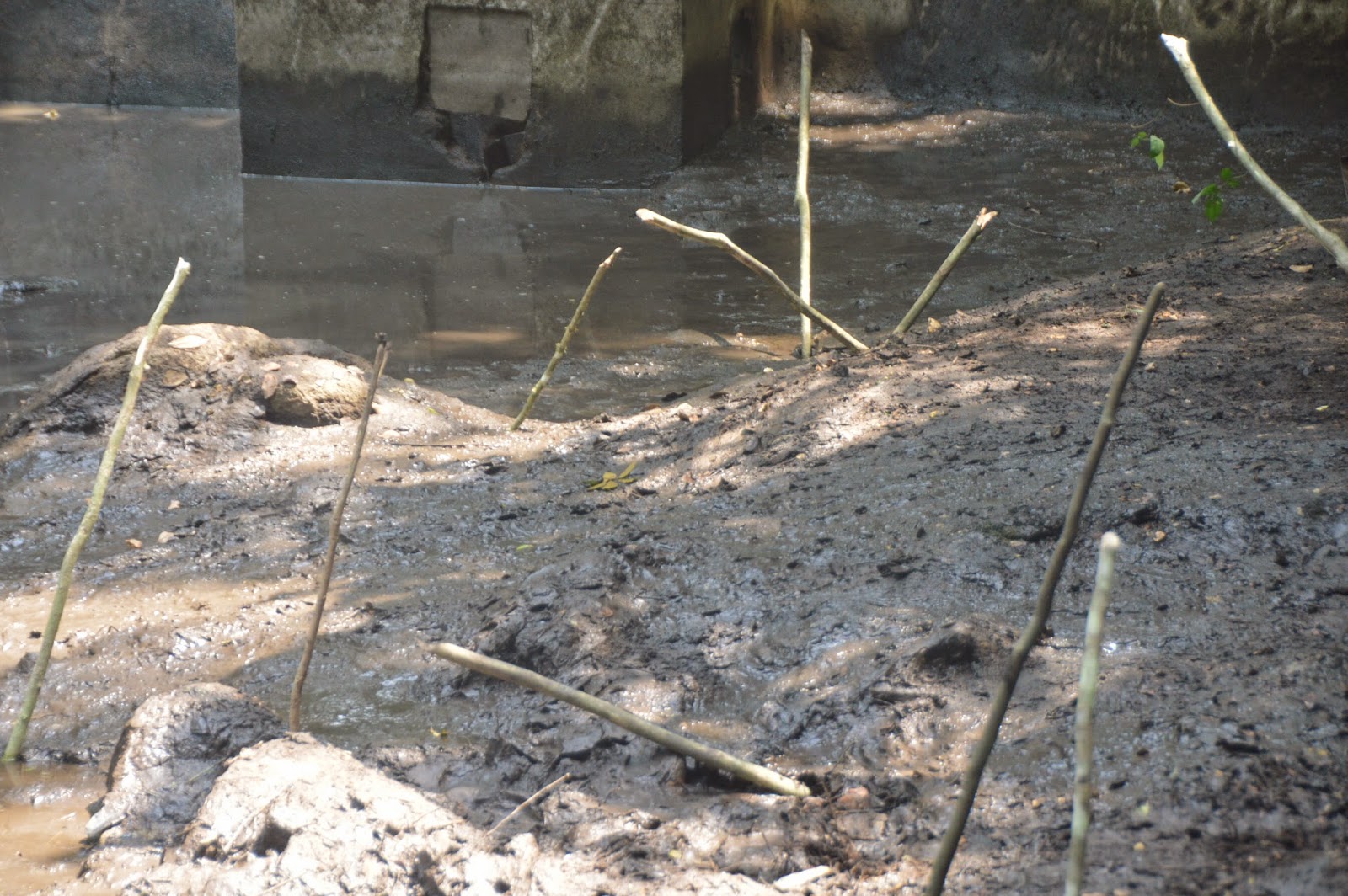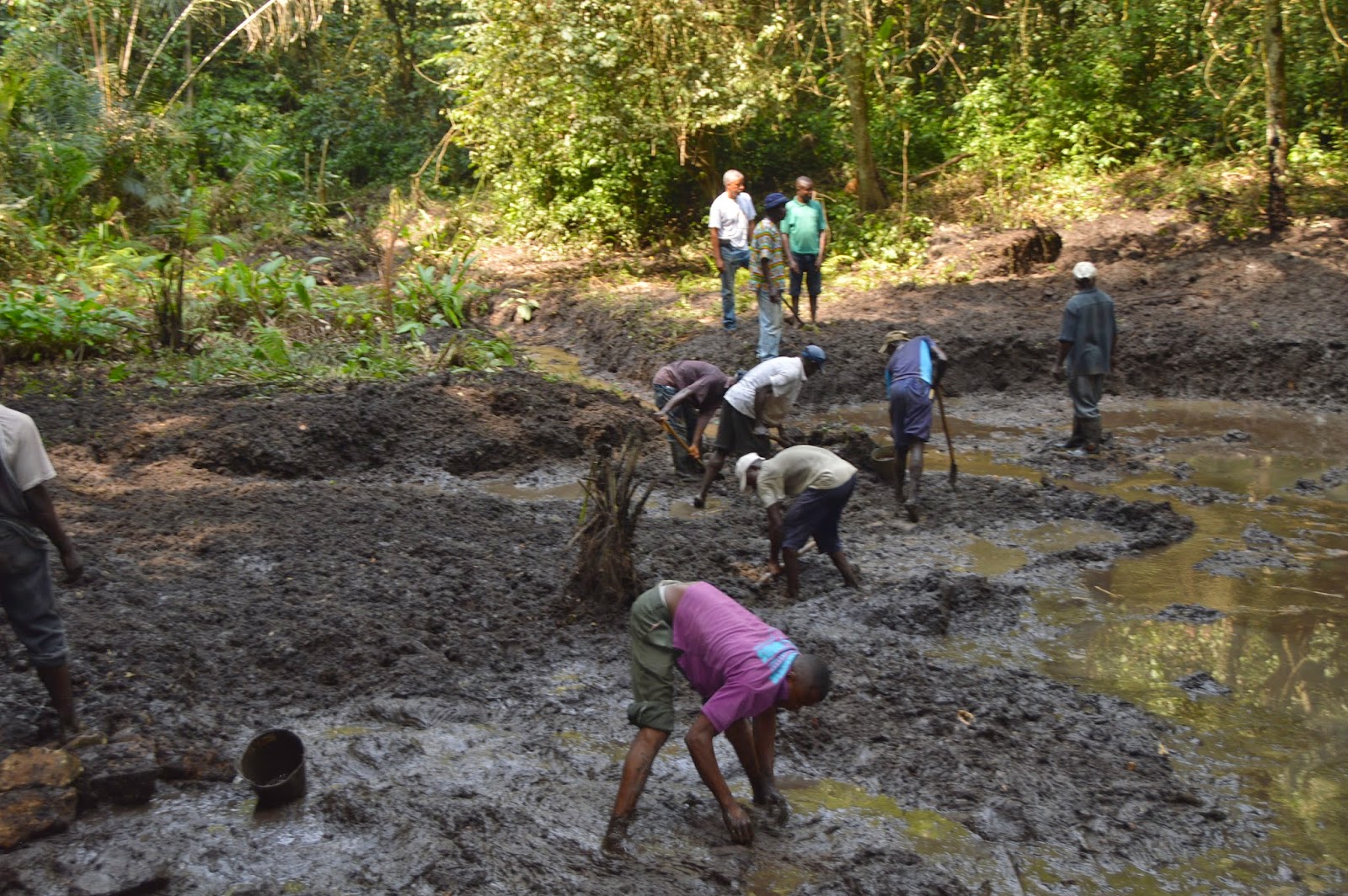Summary: Project to mobilise local authorities and whole community of Kayima, Sandoh Chiefdom. Kono District, Sierra Leone, to repair and renovate Kayima gravity-fed water supply dam to correct heavily polluted water being drunk by towns people, reduce water borne disease, reduce annual soil incursion and increase water resilience through the dry season.
Click on a picture to see it full size
[I lost a lot of the final pictures, which are currently unopenable files on my laptop, due to a corrupted second hand SD card I bought in Sierra Leone. The only ones I have were taken with my mobile phone. If anyone knows a techie who can open them please, please, please get in touch with me.]
 |
| Hand made dam further up stream while works going on. At one point in history the reservoir is reported to have reached this far; a job for tomorrow |
Ideas have been suggested for there to be a series of mini dams before the main dam, each reservoir serving to progressively filter and sediment impurities. Ecological filtration and purification systems could be a viable solution here. Other work remaining to be done include fencing the main reservoir to prevent animals polluting the water, a new stopcock or unsiezing the old one if possible, and a regular sustainable programme of maintenance and inspection. There are at least two in the town who have a special interest in the dam, one of whom would provide cleaning and the other regular inspection and design and management of any upgrading projects. Local knowledge about the dam, its technical aspects, history and specifications varies. IRC should be approached to provide any documentation about their findings and their work in 2003. There may be funding schemes around Africa specifically aimed at repairing and upgrading existing gravity fed water supply systems.
 |
| After much washing away of black silt damage was more visible; one of the many holes in the reservoir floor |
 |
| Hand made dam further up stream while works going on |
Bondu Argue, Mohamed Bockarie and I each donated 10 bags cement, and the 3 of us chipped in for sand and gravel and for the excessively expensive metal filter grill (inflated because of its use in diamond mining)
Kai Fasuluku offered the Cocoa Cooperatives Chinese made power tiller mini tractor to haul sand gravel and cement to the Turntable.
The Section chief paid for a gallon of diesel for the power tiller.
Townspeople carried materials from the Turntable to the dam sack by sack on their heads.
VIDEO: Kasiyatama power tiller dropping off materials at Turntable for toting up to dam
Everybody worked voluntarily without pay, we just provided food on the afternoon of the second day.
We used between 15 and 20 bags cement on the floor repairs for the dam, the left overs were used to reinforce the newly constructed dry stone retaining wall.
 |
| Years of undermining by water erosion, concrete floor of dam was hollow, suspended, we filled the parts accessible with gravel sand cement concrete |
 |
| Repairs being made using a rich mixture of concrete, further examination will be necessary to see how well these repairs bound to existing concrete |
 |
| Showing damage to reservoir floor |
 |
| repairs being made using a rich mixture of concrete, further examination will be necessary to see how well these repairs bound to existing concrete |
 |
| repair to filter inlet |
 |
| replacement filter mesh |
 |
| slowly refilling, dry stone wall in background reinforced in places with cement |
 |
| dry stone retaining wall |
After 3 days of no water supply the pressure was on to refill the reservoir. Concrete was left for a few hours and then water was slowly allowed to flow back in to the reservoir, relying on the presumption that concrete would set well under water. The emergency release pipe was left open.
We had observed during excavation that the bed of the reservoir from about 5 metres away from the dam wall, was sand and gravel. We had asked the workers to stop dredging an area whenever they hit the sand/gravel layer. Some areas were solid but our feet would sink in in other areas. We found this was because organic matter had become impregnated in with the sand and gravel forming a bog. During refilling we proceeded to 'wash' the sand and gravel by stepping up and down with our feet. The sand settled quickly but the organic matter would mix with the water and flow away in the mild current. After some time stamping in one area the sand and gravel would begin to solidify under our feet and the amount of organic silt floating away would decrease. We did this for a couple of hours. Although not completely finished, time limitation meant we had to stop. We left instructions to allow the water to flow for a few more hours and then the emergency waste pipe could be closed to allow the reservoir to fill up overnight. The supply tap to the town was to be kept closed during refilling.
It was impossible to ascertain how much reservoir water would filter through the sand and gravel floor of the reservoir.
The next morning the supply tap to the town was opened, I took a first sample from the mains where it crossed the river at the outskirts of town. Visually the water was completely clear with only a small amount of suspended particles. I had to remove the bottle label to avoid confusing it for purchased bottled water (that clean!).
The second sample taken some time later from the town appeared more polluted, the third and fourth samples taken the following days were slightly less polluted than the second but nowhere near as clean as the first. Compared to the pre-works condition of the water there was noticeable improvement, but not satisfactory. Ongoing monitoring will take place during the current dry season (2015) leading up to April, to compare water quality and resilience.
 |
| first and second post-works water samples |
 |
| first, second and third post-works water samples |
 |
| first, second and third post-works water samples |
 |
| (left) first, second and third post-works water samples (right) fourth sample |
In the following days, we took a further trip up to the dam to investigate the cause. We found fresh evidence of small animals and concluded this could be a factor in disturbing the water. We hypothesised that animals had probably been scared away from the region of the reservoir by several days of intense human activity and had now returned.
 |
| small animal tracks in area around reservoir |









































